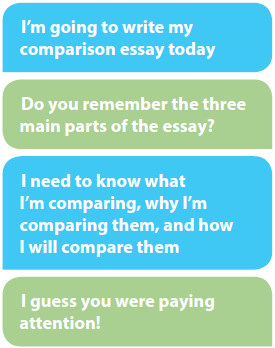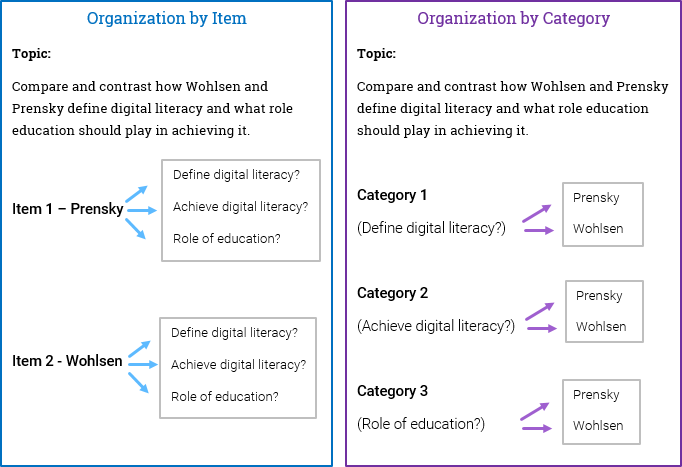To produce a critical comparison, we apply all the summary and critical thinking work about two articles to an outline based on shared categories for comparison. We need to make decisions about how best to organize a comparison, depending on the type of information involved.
This lesson begins by introducing the basic components and structure of a comparison argument. Then, you will practice by filling in an outline template for the comparison essay.
Note
This lesson draws on knowledge of two articles. If you haven’t already, you will want to read them now.
Prensky, M. (2001). Digital natives, digital immigrants. On the Horizon, 9(5). Retrieved 5 October 2001, from http://www.marcprensky.com/writing/Prensky%20-%20Digital%20Natives,%20Digital%20 Immigrants%20-%20Part1.pdf
Wohlsen, M. (2016). Digital literacy is the key to the future, but we still don’t know what it means. WIRED. Retrieved 14 April 2016, from http://www.wired.com/2014/09/digital-literacy-key-future-still-don’t-know-means/
You do not need to have completed Lesson C to enjoy this lesson. If you haven’t completed it, you can use the following resources to help you in this lesson:
Identify Components of a Comparison
A comparison argument might be the basis of an entire essay or a smaller part of a larger work. In every case however, a comparison always includes these 3 core components.
Components of a Comparison (Reference)
| Items to be Compared |
Basis of Comparison |
Categories of Comparison |
| What two things will be compared? |
Why are we comparing the two items? What is our purpose and goal? |
How will the items be compared? What elements of the items will be compared? |
| Example:
Articles by Wohlsen and Prensky. |
Example:
Compare and contrast how Wohlsen and Prensky define digital literacy and what role education should play in achieving it. |
Example:
We will compare and contrast based on three categories – definition of digital literacy, criteria for achieving it, and the role of education in achieving it. |
Select a Structure of Comparison
Comparison arguments can be structured in two different ways: by item or by category.
When deciding how to structure a comparison argument, we need to decide between these two basic structures. To do this, we need to consider the advantages and disadvantages of each structure.
Answer the following questions to reflect on when and why you might best use each comparison structure.


Structure of a Comparison (Sample Answers)
- What do you think the advantages might be of each pattern of organization?
Organization by item allows you to focus on gaining a complete understanding of the arguments and ideas in each article. Organization by category allows for more direct comparison of the articles through the discussion.
- What do you think would be the most suitable pattern of organization for the Prensky and Wohslen essay we have been developing?
Because we are focused on understanding the different ways each author defines terms and approaches ideas about digital literacy, organization by category would be more suitable. This type of organization is almost always the most effective structure when you really want to understand points of intersection and divergence in two articles.
Download Sample Answers
Completing the Outline
We have already done plenty of work towards developing our critical comparison essay. We know why and how we want to compare the articles. We have completed a large amount of summary work and critical thinking to support our content.
The final stage is to put all this work into an outline, ready for writing.
Consider this template for developing an outline for a critical comparison essay.
Critical Comparison Outline Template (Reference)
| Introduction |
Information to include:
- What is being compared?
- Why are they being compared? What is the topic or basis of comparison?
- How will they be compared? What are the categories of comparison?
- What will we learn about the topic when we’ve read this comparison? What is the thesis?
|
| Explore each Category in a series of paragraphs. |
Information to include:
- What is the category? Give an introduction to the idea or issue.
- What does each author have to say about this idea or issue?
- How does each author develop their particular position about the idea and why? (Look at evidence.) What motivates each author to make the argument that they make? (Look at assumptions.)
- What are the key points of similarity and difference in each author’s position?
- What are the implications of each author’s position?
- Do you have thoughts about the value or implications of these different positions?
|
| Conclusion |
Information to include:
- What do we learn about the topic in this essay?
- What conclusions does the essay make about the significance of each author’s ideas and the consequences of each author’s arguments?
|

Now, it’s your turn. Using the template, put together an outline for the critical comparison of the Prensky and Wohlsen articles.
Follow the questions in the outline template and fill in the content. Use the information and ideas about the articles that you have developed through this lesson. You can also use information from the sample answers. As well, you may find that you get new ideas about the articles as you are working. Go ahead and include them too.
When you have finished this activity, you can check the sample answers.


Critical Comparison Outline Template (Sample Answers)
Prensky and Wohlsen
Introduction
- Debate exists around what digital literacy means and the best ways to ensure the education system can provide a younger generation the digital literacy they need to be successful.
- This essay will explore two articles that participate in this debate – Prensky’s 2001 article “Digital Natives, Digital Immigrants,” and Wohlsen’s 2014 article “Digital Literacy is the Key to the Future, But We Still Don’t Know What It Means.”
- Thesis: The different definitions of digital literacy offered by Prensky and Wohlsen shape their arguments about how to achieve it, and the role teachers play in ensuring it is fostered in their students. While Prensky sees a digitally literate youth driving changes to the education system, Wohlsen sees a need to change the education system to ensure we develop a digitally literate youth.
- The essay will be organized around three categories of comparison – defining digital literacy, achieving digital literacy, and the role of education.
Category 1 – How should we define digital literacy? Why?
- Prensky defines digital literacy as the ability to use digital technology effortlessly. He also includes particular use patterns, such as a preference for speed and multi-tasking.
- Wohlsen defines digital literacy as an understanding of the “logic of coding” or “computational thinking,” in direct opposition to, simply, the ability to use the technology. Wohlsen’s extension of this definition past Prensky’s might, in part, be due to developments in the 13 years between when the articles were written.
- Prensky’s argument is motivated by his primary focus – to argue for computer-based innovations in teaching and course delivery. His focus is primarily on the potential to use digital technology in the classroom. In contrast, Wohlsen’s definition matches his own goal. He is looking ahead to the needs of industry and the job market, and is concerned with the problem of raising a generation with the skills society needs. Because of this different definition, Wohlsen’s focus is on making sure we teach children how to become digitally lit
erate, rather than assuming that they already are.
Category 2 – How can we achieve digital literacy?
- Wohlsen’s primary purpose is to emphasis techniques and opportunities to provide digital literacy to today’s youth. He showcases different camps and activities that are designed to take children beyond using technology into an understanding of its inherent logic. His warning is that if we don’t understand these skills as necessary for digital literacy, we will not foster these opportunities to achieve it. In contrast, Prensky warns that if we don’t foster the “digital natives’” literacy, we will alienate them.
- Wohlsen’s arguments for achieving digital literacy assume a very central role for algorithm and data, for computational logic, in society. While this is true, and his evidence seems to support this, he relies on evidence solely within the technology field and this may overstate the significance of these skills in society.
- Prensky’s position makes the difficult assumption that all younger people – his “digital natives” – are inherently literate in technology, drawing on arguments about brain development; in other words, they don’t need to achieve it. The problem here is that his argument erases issues of class or geography that impede access for some young people to technology skills. There is little space in Prensky’s argument to discuss what happens when youth don’t have skills in using technology. Wohlsen’s argument would be much better at finding solutions to closing the skill gap in technology that emerges due to class and geography.
Category 3 – What role does education play in achieving digital literacy?
- Both writers share, however, the view that the education system is primarily responsible for meeting the needs of digital literacy, and that teacher knowledge is the primary impediment to this.
- And both indicate the challenge of educating teachers so that they have the knowledge and skills necessary to meet the needs of their students. Again, because of differences in their definition of digital literacy, the emphasis on what teachers need to learn and do is different. For Prensky, the challenge is for teachers to teach differently, embracing the use of technology and emphasis on multi-tasking and speed, in order to engage students. For Wohlsen, the challenge is one of knowledge – teachers cannot teach an understanding of code and algorithm if they don’t have it themselves.
Conclusion
- The debate around digital literacy demonstrates several tensions in society as we learn to incorporate digital technology into every aspect of our lives. First, the differences in how each author defines digital literacy over the 13-year period indicates our evolving understanding of the skills we will need in a technology-driven society. Second, it’s crucial that we don’t assume our younger generation has all the skills they need; rather, we need to assess these needs on an on-going basis as our technologies change and as our relationship to those technologies changes.
Download Sample Answers





